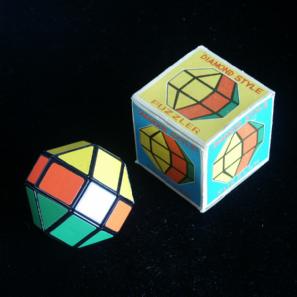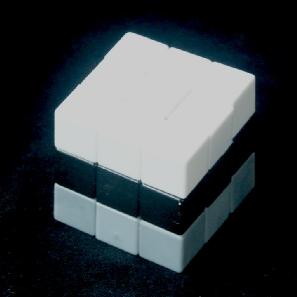



The Diamond Style Puzzler is a variant of the Rubik's Cube. It has the same mechanism but a different outward shape, namely approximately that of a Rhombicuboctahedron. This is the ball-like shape that arises when all 20 moving pieces of the cube are shaved down so that each piece is flat and has only one facelet. Thus the corners pieces have become triangular, and the edge pieces have become square (or actually rectangular) similar to the shaved edges on the Octagon/Barrel. The puzzle has a simple colour scheme where the three layers each have a single colour - the middle layer is orange, the top and bottom layers are yellow and green.
There is another puzzle in my collection which is equivalent. It is a Rubik's cube in which each layer is made from a different colour plastic (white, black, and grey) and does not have stickers. It was made by mixing the pieces of three types of Rubik's Cube. It was never produced commercially.
If your browser supports JavaScript, then you can play the Diamond Style Puzzler by clicking the link below:
I have done a computer analysis of the Diamond Style Puzzler in order to find God's Algorithm. The results are in the tables below. Analogous to the Rubik's cube, there are two ways to count the moves. The Face Turn Metric means that a turn of any disk by any amount is a single move. The Quarter Turn Metric means that only 90 degree turns are single moves. The table shows it can always be solved in at most 8 face turns (6.2089 on average) or 9 quarter turns (7.1480 on average).
| Face turn metric | |||||||||||
|---|---|---|---|---|---|---|---|---|---|---|---|
| Q u a r t e r t u r n m e t r i c | 0 | 1 | 2 | 3 | 4 | 5 | 6 | 7 | 8 | Total | |
| 0 | 1 | 1 | |||||||||
| 1 | 8 | 8 | |||||||||
| 2 | 4 | 72 | 76 | ||||||||
| 3 | 64 | 608 | 672 | ||||||||
| 4 | 14 | 872 | 4,868 | 5,754 | |||||||
| 5 | 370 | 10,160 | 36,416 | 46,946 | |||||||
| 6 | 32 | 6,478 | 110,368 | 209,815 | 326,693 | ||||||
| 7 | 1,292 | 84,502 | 828,820 | 335,896 | 1,250,510 | ||||||
| 8 | 26 | 10,192 | 319,808 | 459,282 | 490 | 789,798 | |||||
| 9 | 16 | 1,008 | 3,952 | 66 | 5,042 | ||||||
| Total | 1 | 12 | 150 | 1,882 | 22,824 | 241,494 | 1,359,451 | 799,130 | 556 | 2,425,500 | |
Of course any solution of the normal Rubik's Cube can be used. I will give a solution below that takes advantage of the fact that this puzzle is so much simpler than the cube.
Phase 1: Solve the orange middle layer.
Phase 2: Solve the edges (rectangles).
Phase 3: Solve the corners (triangles).